8008135 Breast Cancer Myths
25 MINS to read
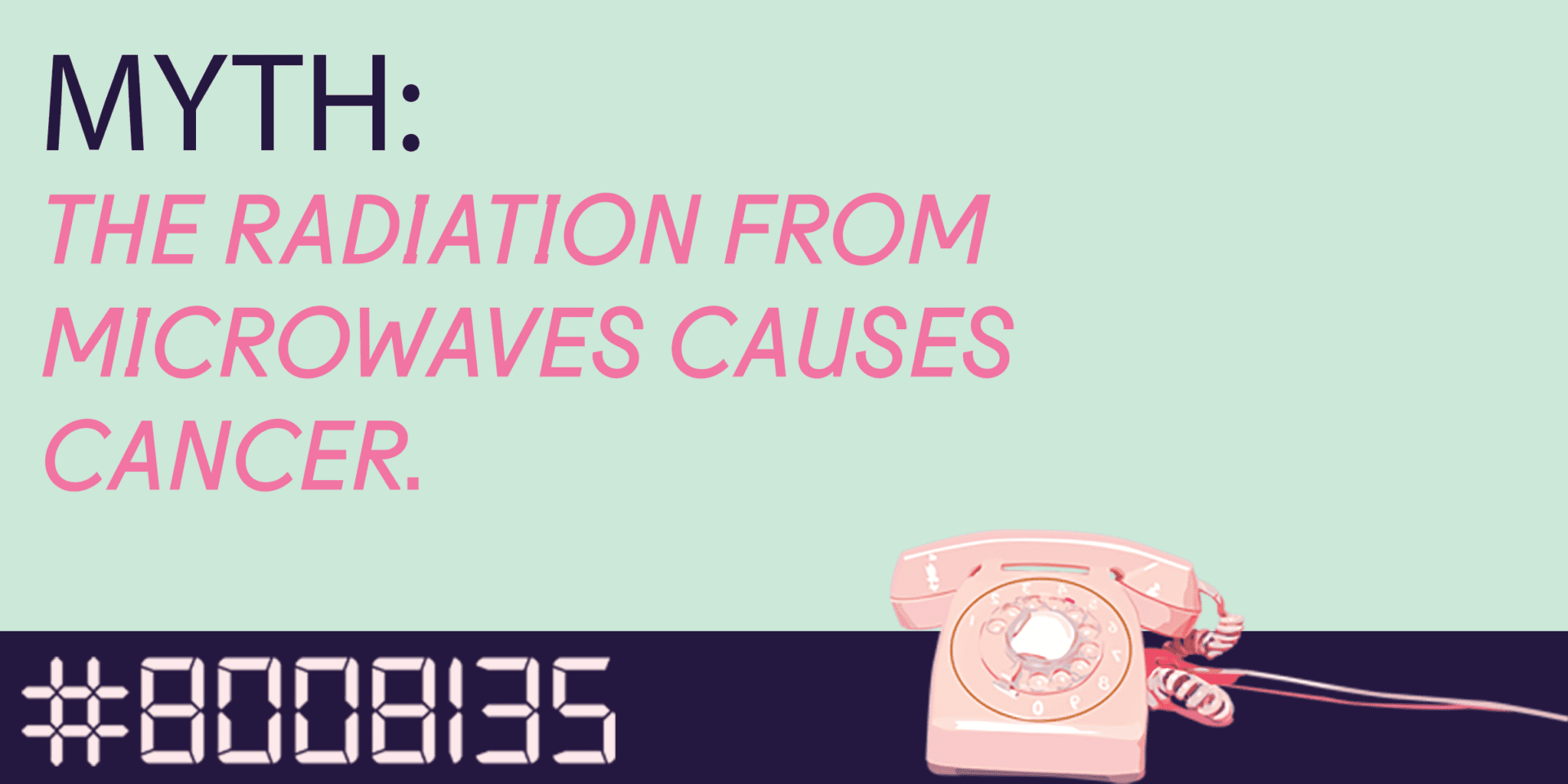
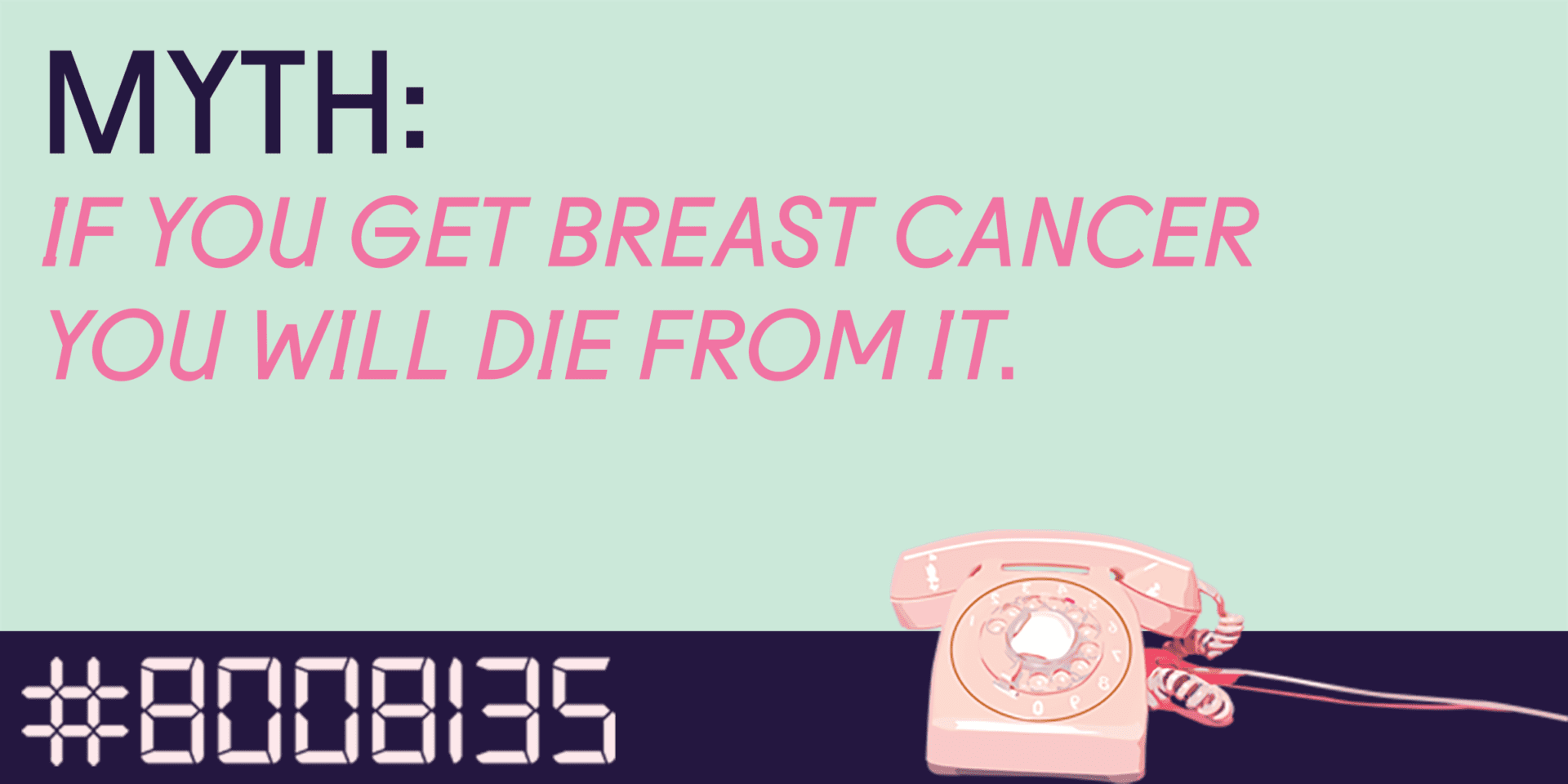
No. It is very much possible to survive a breast cancer diagnosis and to have a full recovery or no evidence of disease (NED or no visible sign of cancer) after treatment. The average 5-year survival ratio for women of all ages with breast cancer is 87% (89.7% in the U.S.). This is very high in comparison to other cancers and treatments have come a long way!
In Canada, the breast cancer mortality rate has fallen 44%. According to the Canadian Cancer Society, on average, for every 100,000 females, only 23.2 will die from the disease. In the United States, per 100,000 females only an average 21.2 will die from the disease.
Statistics tell us that cancer is the leading cause of death in Canada. Images of cancer we see in the media or in films don’t always portray it as recoverable. So, as a society, we often associate the word “cancer” with death. However, in reality, the overall breast cancer mortality rates in Canada and the United States have been decreasing greatly over the past decades. This is likely due to improved overall cancer control, including increased mammography screening and the use of more effective therapies following breast cancer surgery. The 5-year survival rate, specifically for young women under 40, is steadily improving at 85%.
While there is still a lot to do in terms of research for new and improved breast cancer treatments (particularly for metastatic breast cancer) and while it’s still important to limit our exposure to known carcinogens, it’s also important to keep complicated topics from being misinterpreted and spread as frightening rumours. Right now, many women are surviving breast cancer diagnoses and this is something we should be proud of!
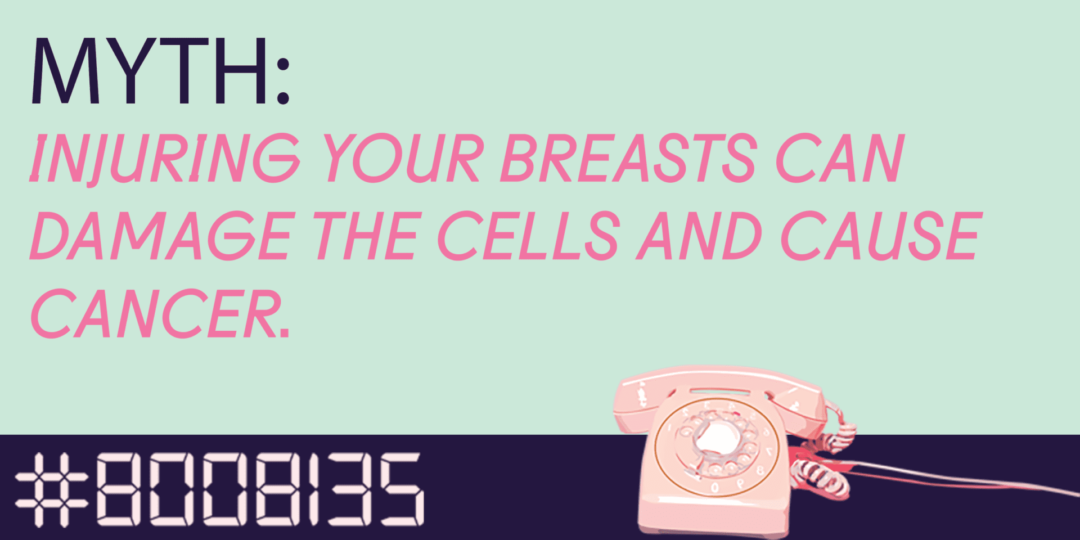
NO. Breast injuries don’t cause cancer, but rather may lead to the discovery of breast cancer in the injured area.
While it’s important that we are protect our breasts from exposure to toxins and injury, it’s also important that we keep complicated information and issues from being misinterpreted and spread as fear.
Sometimes breast injury can cause a benign (non-cancerous) lump called a fat necrosis. However, more often, the Canadian Cancer Society suggests that a cancer diagnosis may happen after physical injury because the treatment for the injury leads to the discovery of a cancer that was already there. For example, if a person breaks a bone and goes to the hospital to get examined they might find that a cancerous tumour caused the bone to weaken, ultimately causing the break.
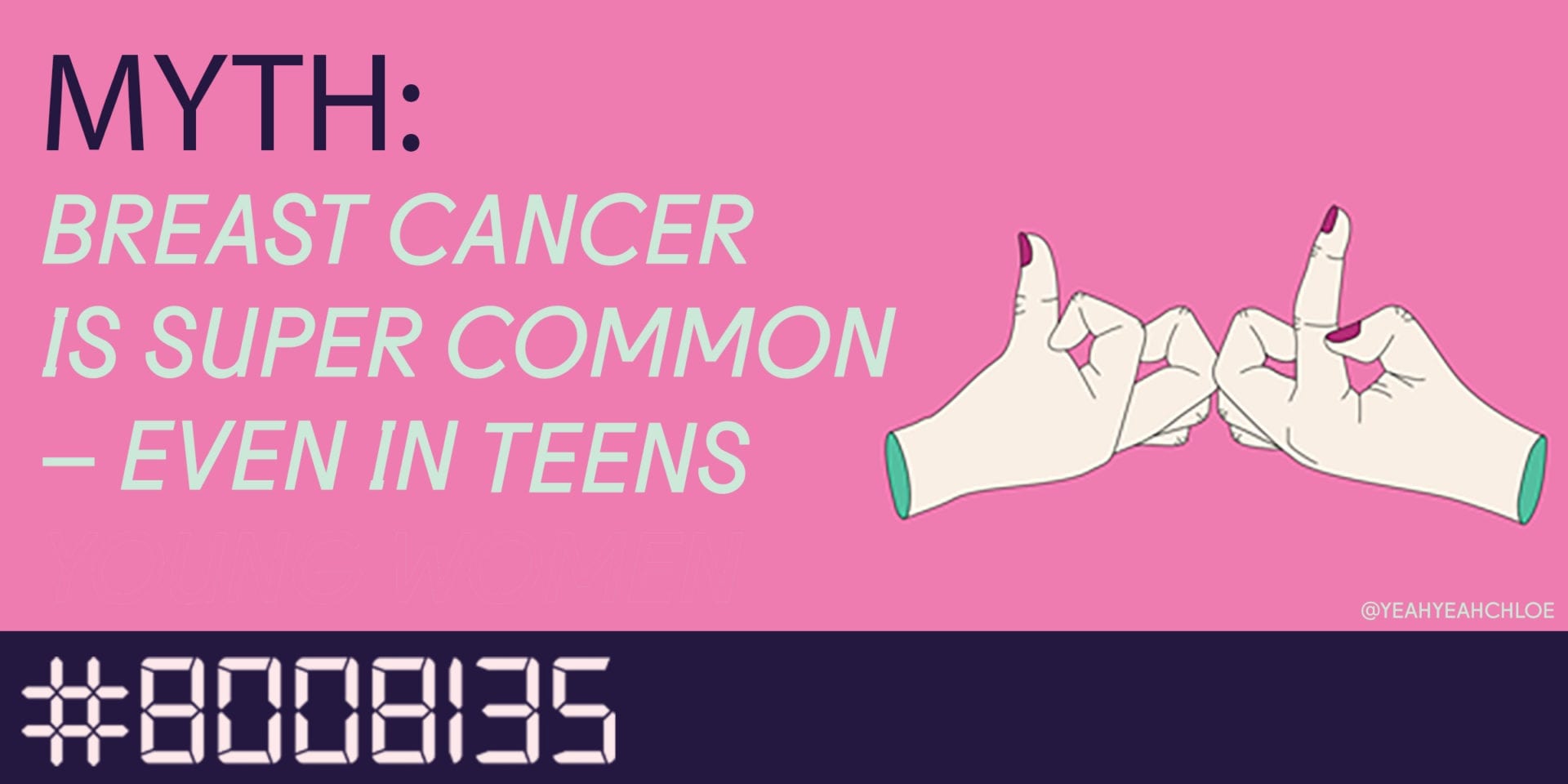 Myth: Breast cancer is super common – even in teens
Myth: Breast cancer is super common – even in teensBreast cancer is the most common form of cancer in Canadian and American women. However, research shows it’s extremely unlikely for teens and young adults to get breast cancer. There’s actually only a <0.06% chance that a person under age 20 will get it.
While it’s important that we are aware of breast cancer risk and the ways we can reduce it, it’s also important that we keep misinterpretations about teen risk from spreading into frightening rumours.
So, where did this myth come from? The media has long emphasized women’s risk of breast cancer, stating that it’s 1/9 in Canada and 1/8 in the United States. This has led a lot of young women to overestimate their risk. Many of them think that, on any given day, they have a 1 in 9 chance of developing breast cancer. This is not true. The chances of a woman getting breast cancer in her entire life time are 1/9 (Canada) or 1/8 (U.S.). In Canada, a woman’s average lifetime is about 90 years. So, it’s more accurate to say that 1 in 9 women in Canada who reach the age of 90 can expect to develop breast cancer.
Research shows that your risk for breast cancer becomes less and less likely the younger you are. According to the Canadian Cancer Society, it was estimated that, in 2016, 86% of breast cancer diagnoses in Canada would occur in women over 50 years of age (51% in women 50 to 69 years of age and 32% in women over the age of 69). The American Cancer Society estimated that, in 2015, 77% of diagnoses in the U.S. would occur in women over 50 (54% in women 50 to 60 years of age and 22% in women over the age of 69). But, only 5% (Canada) and 5.7% (U.S.) of breast cancer diagnosis occur in women under 40!
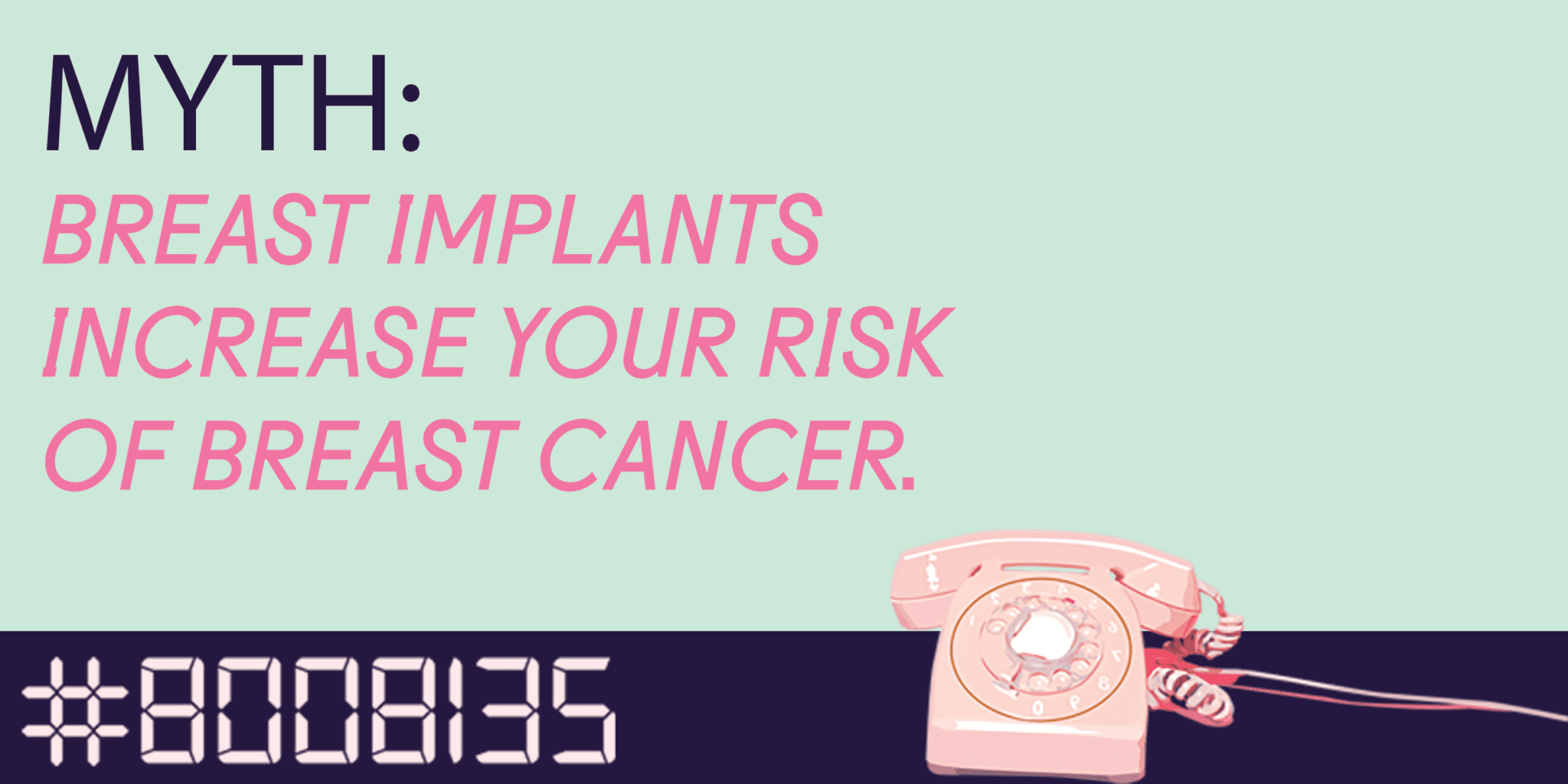
In most cases, breast implants have not been found to increase breast cancer risk. Rather, breast implants can lead to scar tissue formation in the breast and can make mammograms a bit harder to read.
While it’s important that we all do our research and exercise caution around intensive surgeries — like breast alterations — there are also many women who undergo breast reconstruction post-breast cancer. Therefore, it’s important that we are keeping complicated topics and information from being misinterpreted and spread as frightening rumours.
In most cases, breast implants have not been found to increase breast cancer risk. Rather, breast implants can lead to scar tissue formation in the breast and can make mammograms a bit harder to read.
According to the American Cancer Society and the U.S. Food and Drug Administration (FDA), a possible association has been found between breast implants and breast implant-associated anaplastic large cell lymphoma (BIA-ALCL). The FDA and the World Health Organization (WHO) suggest that BIA-ALCL is an extremely rare form of cancer that is more likely to occur in the scar tissue around textured implants, as opposed to smooth ones. Still, most research concludes that this occurrence is highly rare and, when it does occur, is very responsive to treatment.
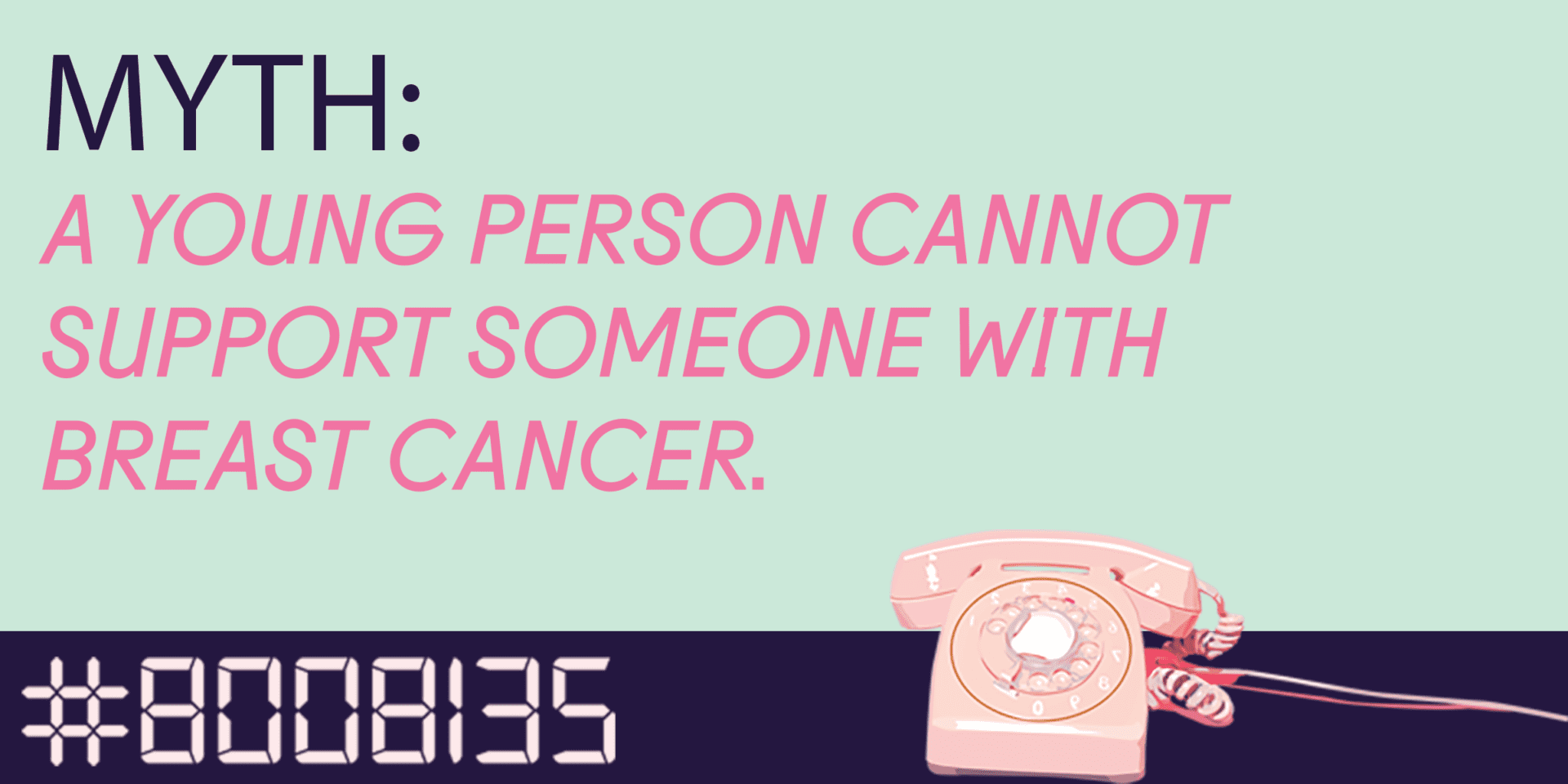
Just showing up and letting you know you are there for them is the best way to show that you care. Pop by for a visit, send a care package, or write a text letting them know you are thinking of them.
There are many ways to get involved in the cause like volunteering your time at a fundraising event, throwing your own event to raise money and awareness, or supporting a breast cancer charity of your choice, like Rethink (consider joining the movement today!)
If you know someone who is going through breast cancer, here are some more suggestions for how you can show you Give-A-Care.
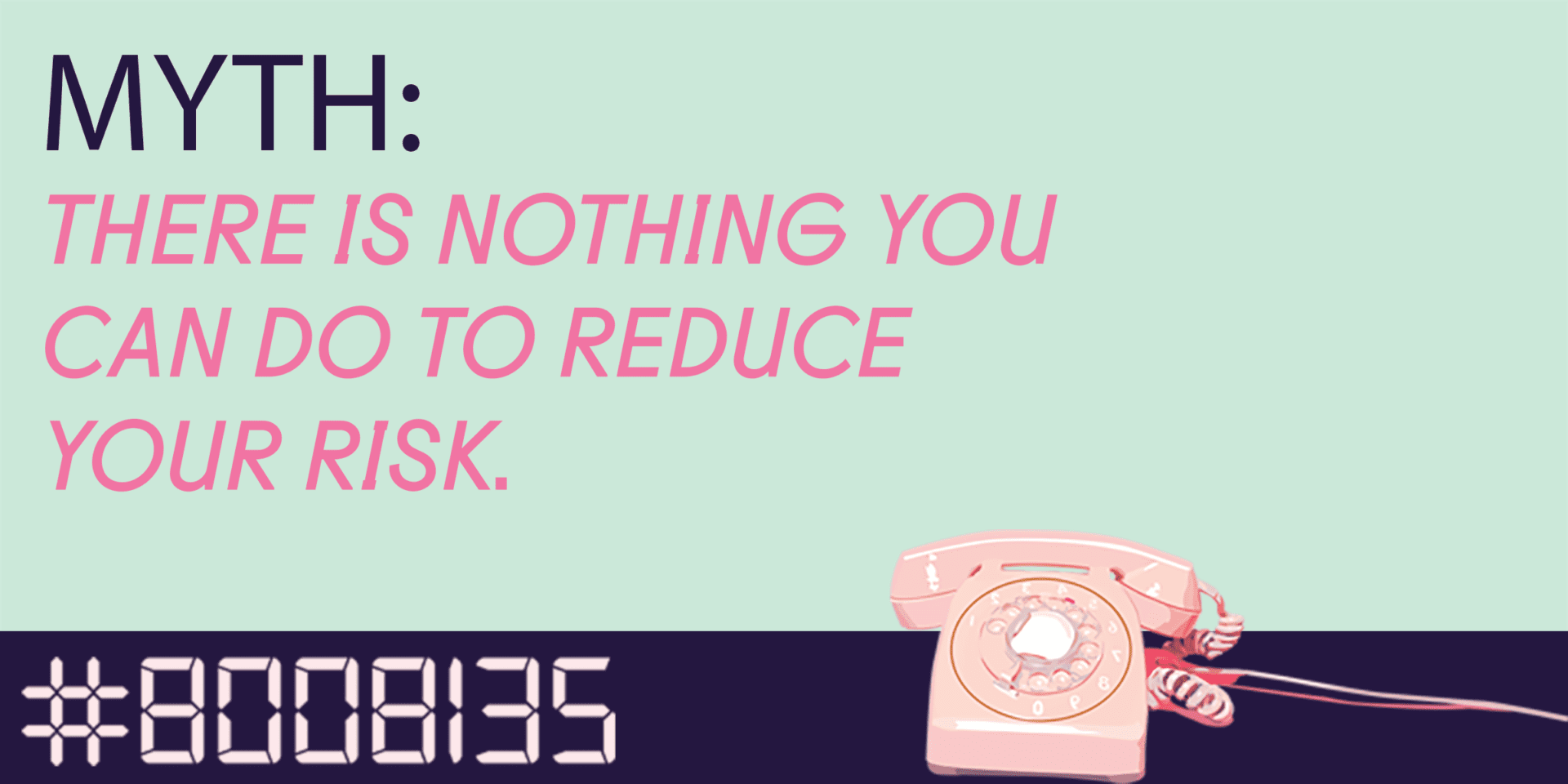
While it’s important that we all exercise caution around exposure to toxins and known carcinogens in our environment, it’s also important that we keep complicated information/issues from being misinterpreted and spread as frightening rumours. There’s nothing anyone can do to become “immune” to breast cancer. However, there are many things you can do to reduce your risk for developing the disease. 1/3 of cancers can be linked to lifestyle factors including diet and exercise so creating healthy habits while you are young, like exercise, will help to reduce your risk and ensure that you are putting your health front and center for the rest of your life.
Physical Activity: Research shows that any quantity of regular exercise is beneficial, with the frequency, intensity and consistency directly related to the benefits in reducing risk. According to a 2017 study by the World Cancer Research Fund, premenopausal women who exercise vigorously have a 17% lower risk of breast cancer and postmenopausal women who do the same have a 10% lower risk compared to women who rarely exercise. Additionally, women who exercise moderately (ie/ walking or gardening), have a 13% lower risk of breast cancer compared to sedentary women.
Additionally, recent research from the University of Toronto has shown that regardless of how much exercise a person gets, sitting too much has negative health impacts. Sedentary behaviour has been independently associated with chronic disease-related risk factors such as central adiposity, insulin resistance and inflammation. These factors are hypothesized to be operative in the development and progression of breast cancer.
Healthy Body Weight: Rethink encourages young women to have their doctor check their Body Mass Index (BMI) to help indicate a healthy body weight. Numerous studies have demonstrated the association between being overweight (defined as BMI of 25 to 29.9) or obese (BMI of 30 or greater) and breast cancer incidence. A study by the International Agency for Research on Cancer (IARC) in 2016, found a correlation between body fat and cancer risk, where those with an absence of excess fat had reduced risk for most cancers.
The effect of weight on breast cancer risk is due to differences in the levels of the female sex hormones estrogen and progesterone. Although these natural hormones are important in the body, they can encourage some breast cancers to grow. The more fat tissue you have, the higher your levels of estrogen are likely to be and this, in turn, increases your risk of breast cancer. Fat also contributes to the body’s ability to fight cancer by decreasing the immune response and increasing inflammation through increased glucose and insulin in the body responses, both of which are involved in cancer (Source). Regular exercise and a balanced diet are key to maintaining a healthy body weight.
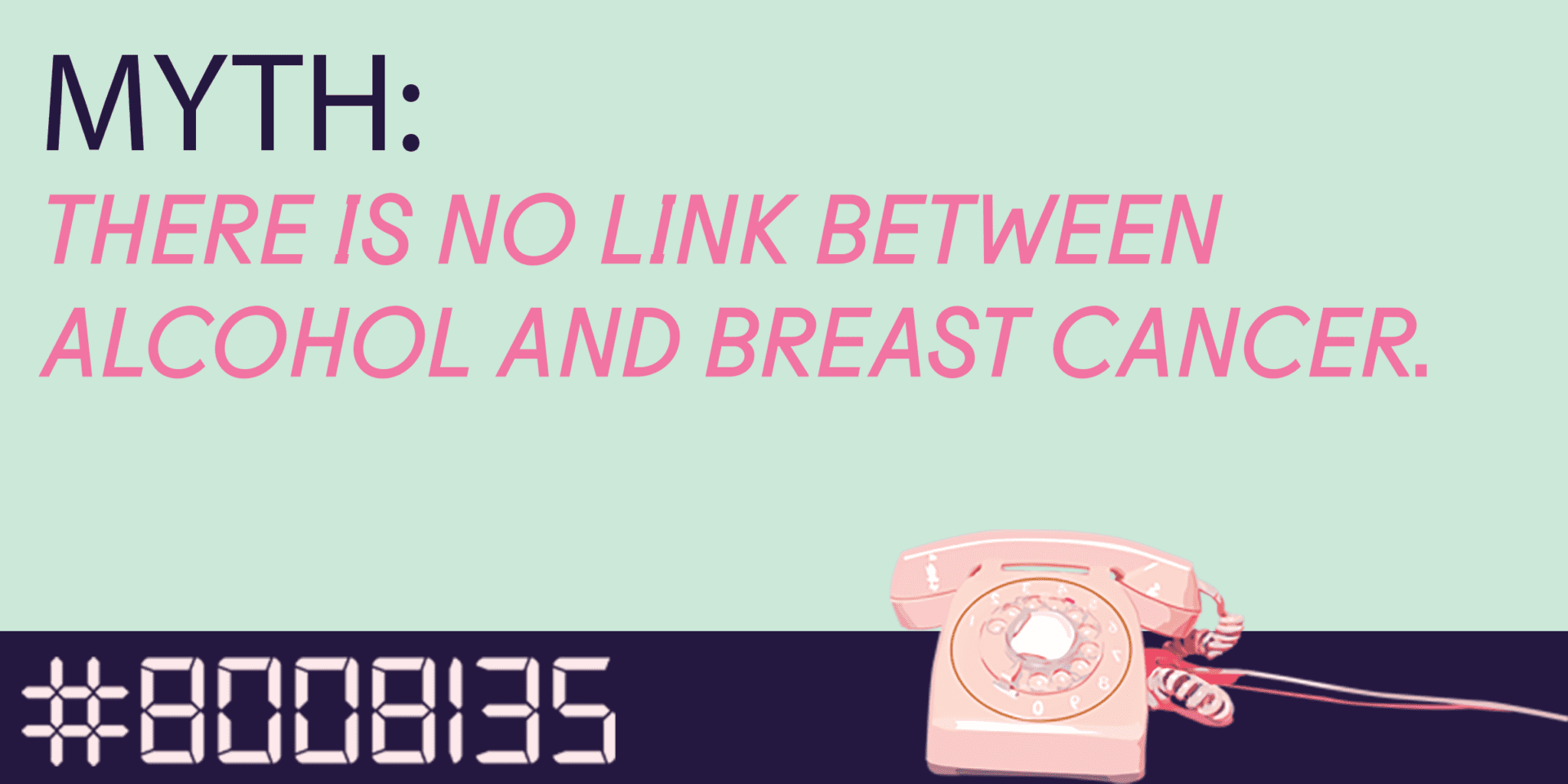
Drinking alcohol can increase your risk of breast cancer. Studies have shown a correlation between drinking alcohol and breast cancer risk, with risk increasing with each additional drink consumed per week.
While we don’t endorse underage drinking, it is important to know the facts about alcohol, breast cancer, and breast cancer development. Evidence shows that the risk of developing breast cancer increases for those women drinking during the decade after their period begins and before their first pregnancy. This occurs as alcohol increases the levels of estrogen and other hormones associated with hormone-receptor-positive breast cancer.
Studies have shown that women who drink three alcoholic drinks per week are at greater risk (15% higher) than women who don’t. This risk goes up another 10% with each additional drink consumed. Similarly, young girls ages 9 to 15 who consume alcohol regularly (three to five drinks per week), have a three times greater risk of developing non-cancerous breast lumps (some of which could be associated with a higher risk of breast cancer in later years).
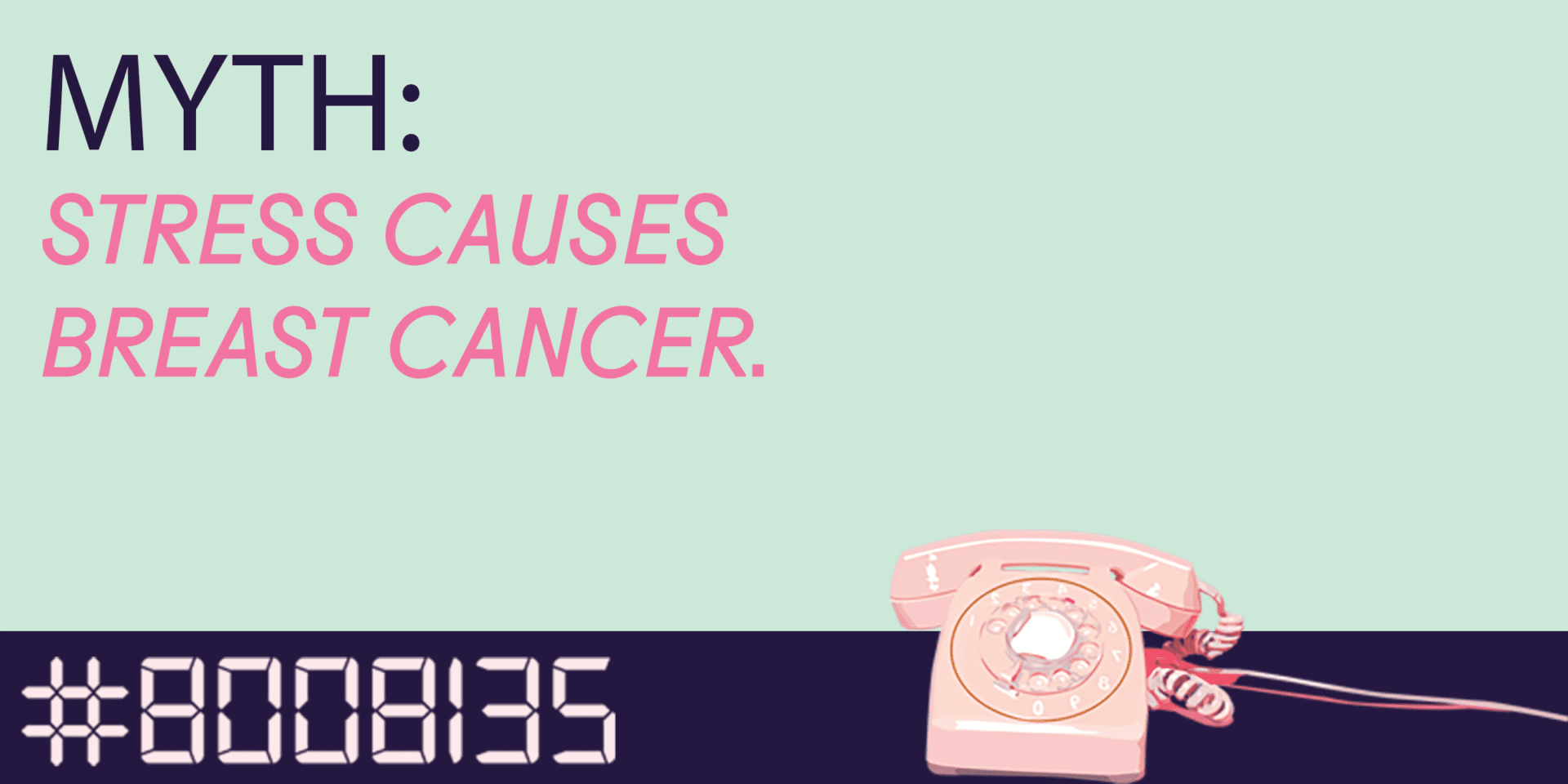
No. While it would give us something to blame, most evidence suggests there is no link between stress and cancer. Rather, stress can lead to unhealthy lifestyle habits, which could potentially increase a person’s risk.
While it’s important that we are putting our mental health as a priority in our lives, it is also important that we are not misinterpreting complicated information and issues to spread fearful rumours. According to Cancer Research UK, a combined study in 2013 of 100,000+ people found no link between stress and breast cancer. However, unhealthy habits (such as: smoking, overeating, binge, drinking, etc.) that people often take on when they are stressed are known to increase a person’s risk of breast cancer.
Speak to your health care provider to find ways that you can manage stress and don’t forget to show yourself some love.
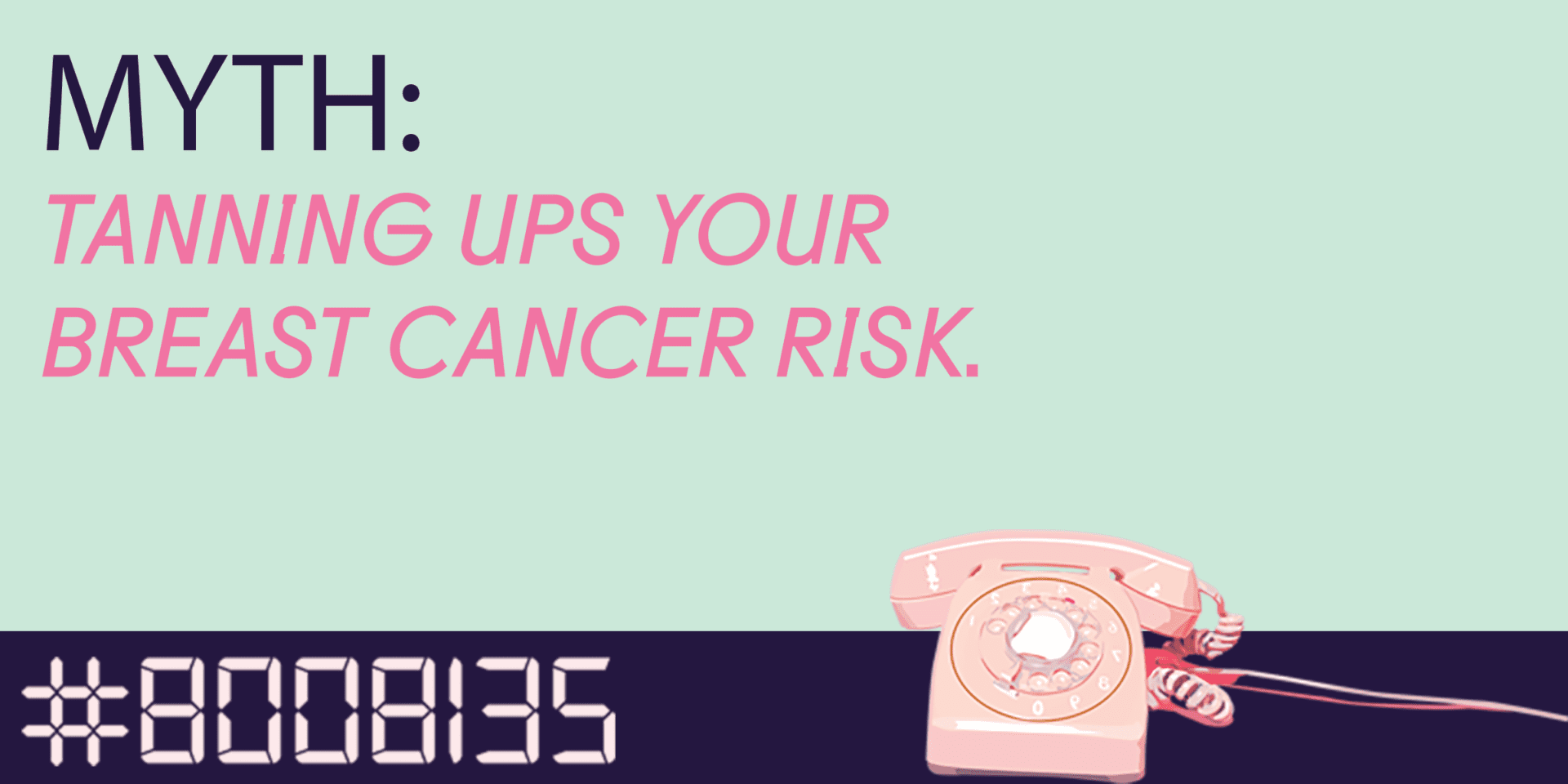
No. There is no evidence that tanning causes breast cancer, although there is plenty stating that it causes skin cancer.
It’s important that we are protecting our skin from harmful UV rays, but it’s also important that we keep information about certain kinds of cancers from being associated with all cancers and spread as frightening rumours. There is no evidence that tanning causes breast cancer, although there is plenty stating that it causes skin cancer.
According to the Canadian and American Cancer Societies, tanning is not safe for your skin – indoors or outdoors because of exposure to harmful UV rays. It is recommended that you always use sunscreen (SPF 30+) when you will be outside for a longer period of time. As well, the Canadian Cancer Society encourages people to stay away from indoor tanning beds – which can expose you to radiation five times more than the sun.
While you can rest assured that tanning will not affect your breasts, you should try to avoid it for many other reasons. If that summer glow is an absolute must-have the Canadian Cancer Society recommends using sunless tanning creams or other methods of “fake tanning.”
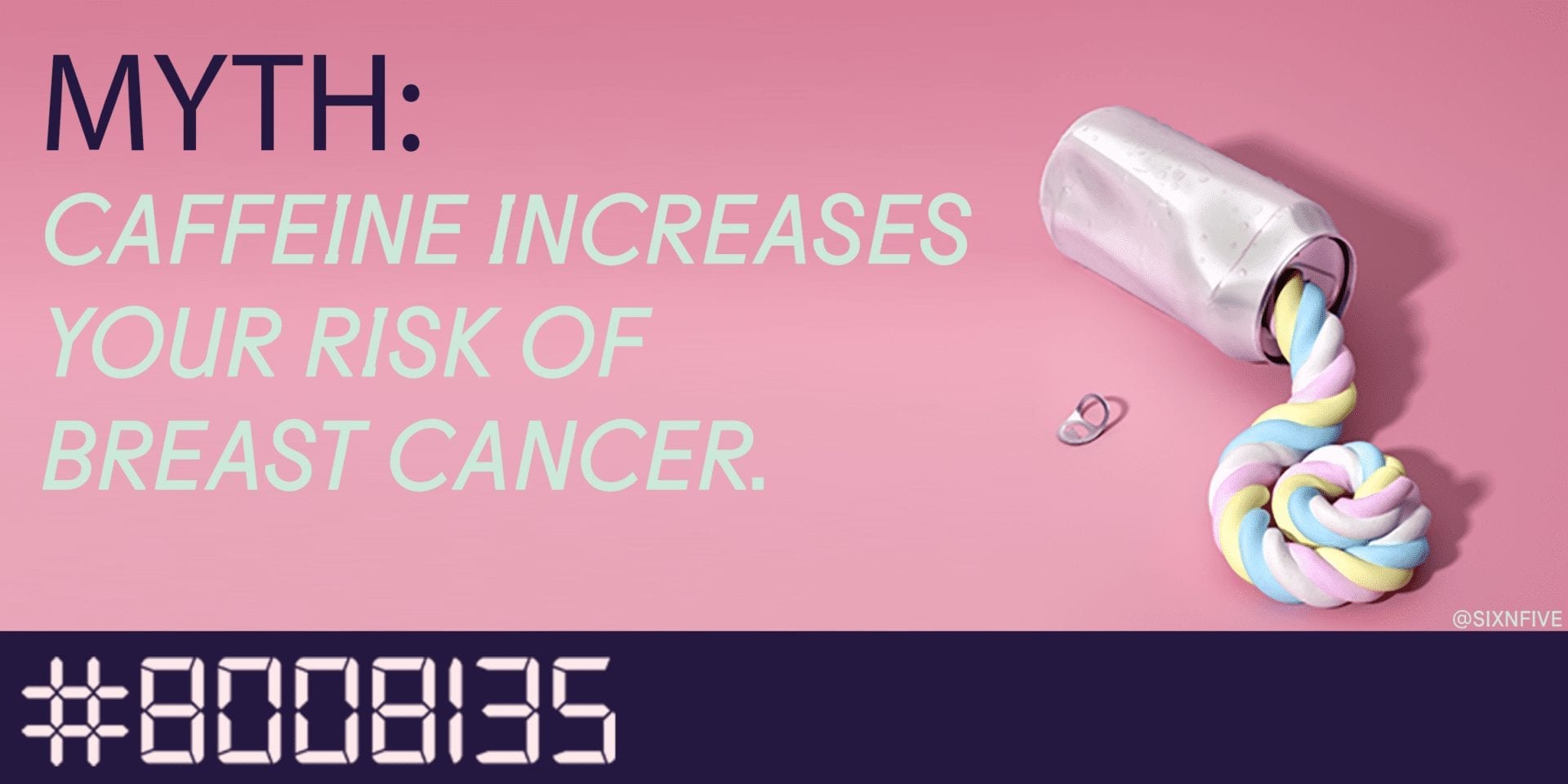
No. Studies have found no link between the consumption of caffeine and an increased breast cancer risk. Rather, some studies have found that caffeine may actually decrease a person’s risk.
There have always been quite a few concerns surrounding the use of caffeine – some true and some false. You’ve probably heard people say that caffeine stunts your growth, or that it can dehydrate you, or make it difficult to get pregnant. And now it seems that people are saying caffeine can give you breast cancer. While it’s important that we all exercise caution around the substances we are putting into our bodies, it’s also important that we don’t give in to the “everything causes cancer” mentality and spread frightening rumours as a result.
So, here’s what you need to know about caffeine. Two studies, one Swedish and one German, studied thousands of postmenopausal women and their health histories – half that were diagnosed with breast cancer and the other half that were not. Here’s what they found:
Similarly, the European Prospective Investigation into Cancer and Nutrition (EPIC) cohort study came to the same conclusion.
While there is no magical drink or food that can make you immune to breast cancer, these studies at least reassure us that caffeine doesn’t cause breast cancer. Drinking too much coffee can contribute to other negative health effects – but cancer isn’t one of them. So, as always, moderation is key, as well as the implementation of other daily activities and practices that can reduce your risk.
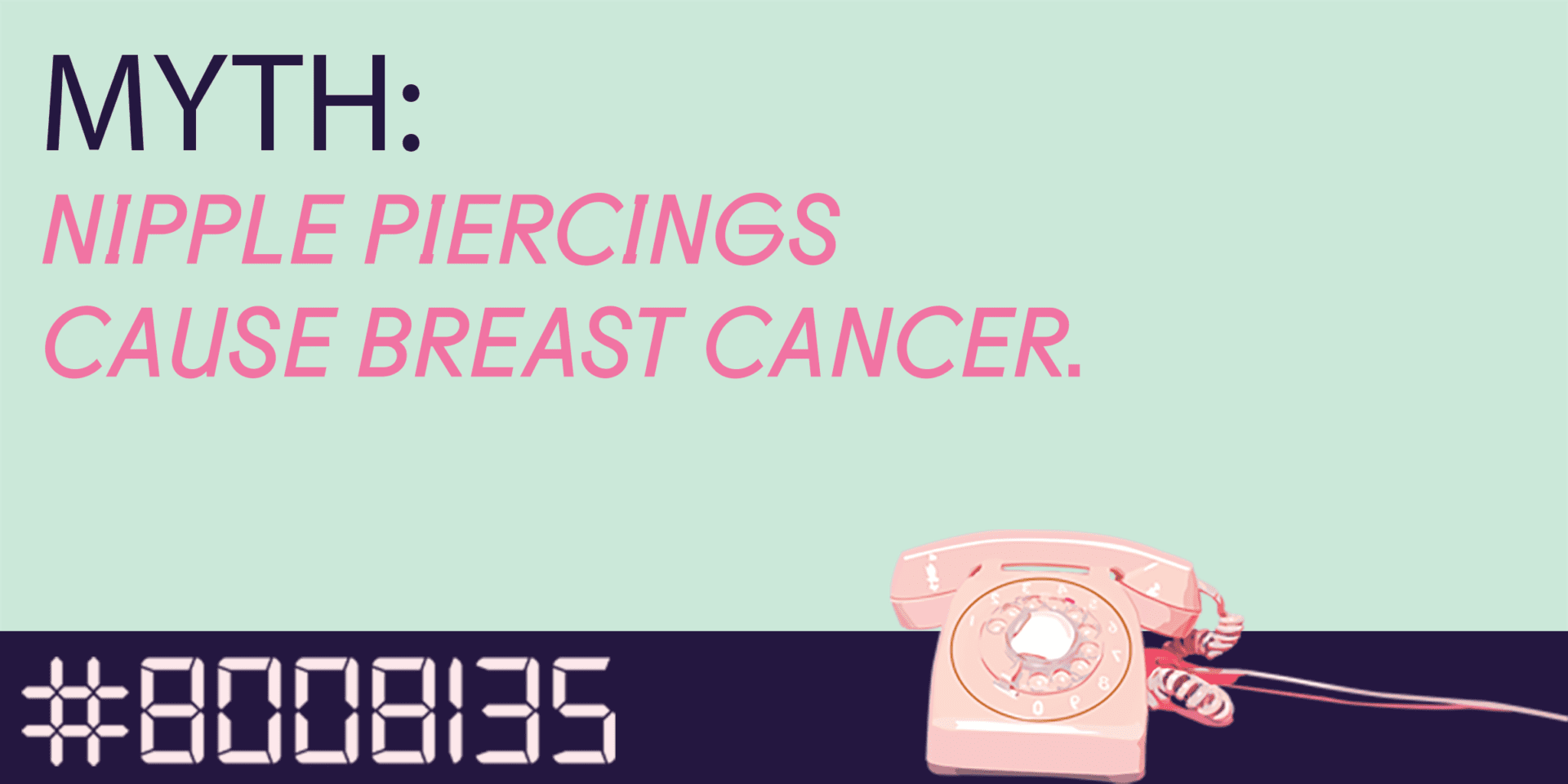
No. There is no correlation between nipple piercings and breast cancer. However, these kinds of piercings do have a plethora of potential health effects, some that can mimic symptoms of breast cancer.
While it’s important the we exercise caution around what we do to our bodies and the ways we alter them, it’s also important that we don’t allow complicated and controversial issues to be misinterpreted and spread as frightening rumours. No, there is no correlation between nipple piercings and breast cancer. However, these kinds of piercings can cause different potential health effects, some that mimic symptoms of breast cancer.
According to the Maurer Foundation, there are no studies that link nipple piercings and breast cancer. However, they can lead to issues breastfeeding in the future and other health complications, such as:
These issues are usually treatable.

No. Using microwave ovens does not cause cancer because microwaves cannot make food radioactive.
It’s important that we all exercise caution around exposure to toxins and known carcinogens in our environment, but it’s also important that we keep complicated information/issues from being misinterpreted and spread as frightening rumours.
According to the American Cancer Society, microwaves are absorbed by the water molecules inside food, which causes them to vibrate and produce heat. However, microwave ovens don’t use x-rays or gamma rays – which would actually be harmful to humans. When used properly with the door closed, the microwaves are contained inside the microwave oven.
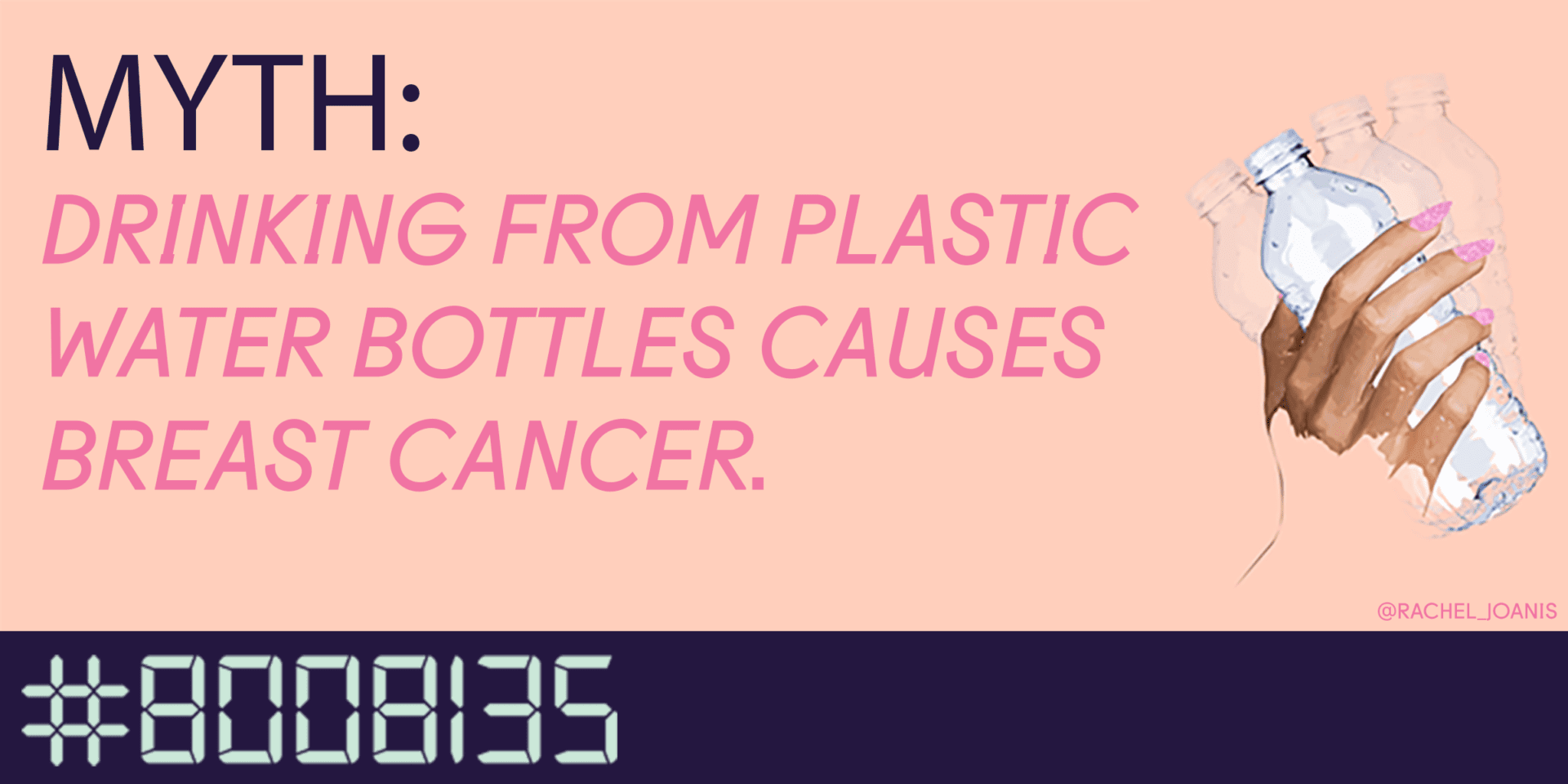
No. Using disposable plastic water bottles does not increase a person’s cancer risk. However, reusing plastic water bottles can potentially cause sickness (vomiting or diarrhea) because of germ growth – but not cancer.
While it’s important that we all exercise caution and monitor our exposure to toxins and known carcinogens in our environment it’s also important that we keep complicated information/issues from being misinterpreted and spread as frightening rumours.
Some worry that DEHA, a well-known plasticizer used to make plastics less brittle, can leak out of the plastic into water. However, according to the Canadian Cancer Society, there is no proof that DEHA is cancerous.
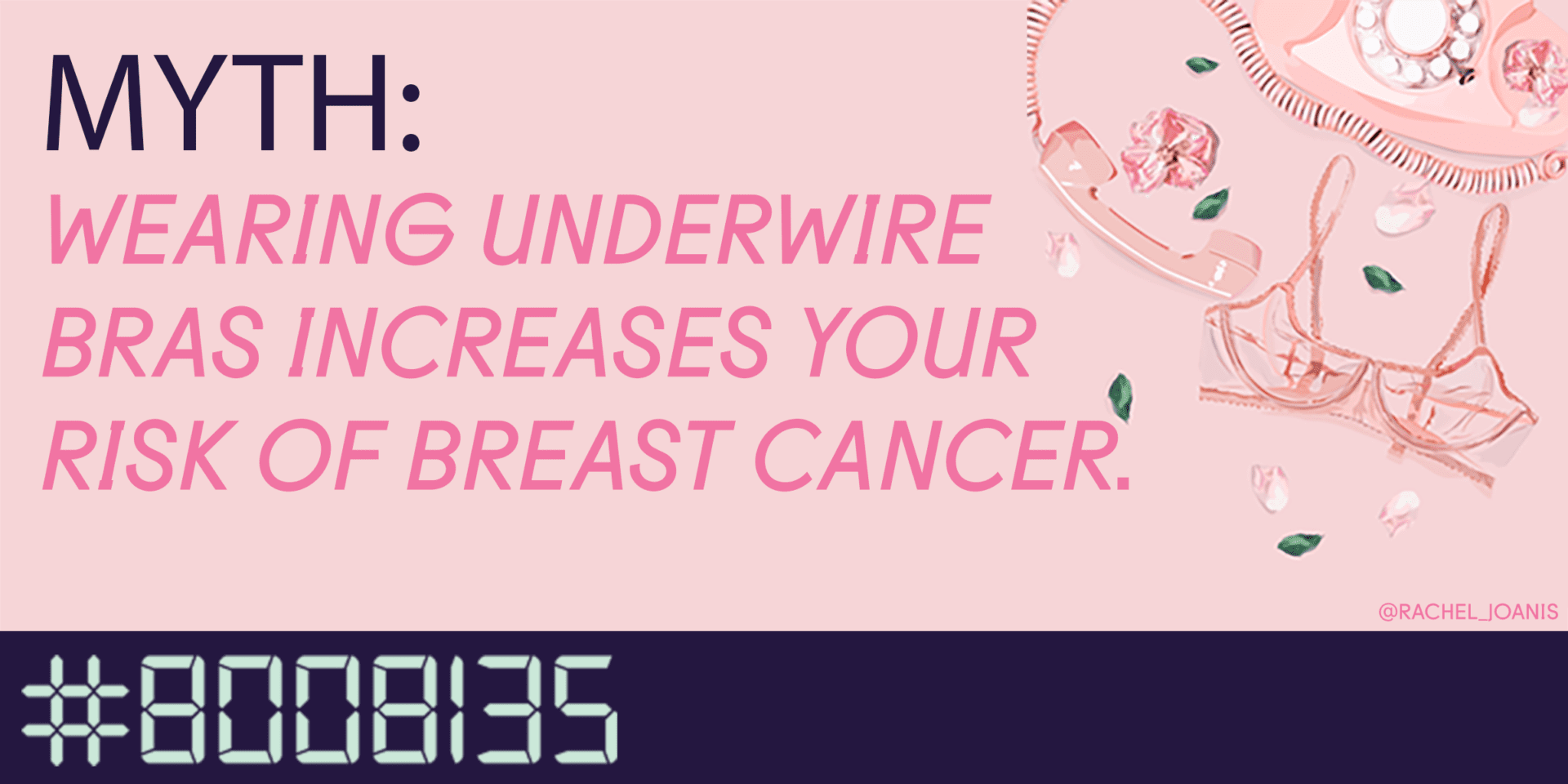
No. There has been no causal link found that ties breast cancer to the use of underwire bras – or any bra!
This myth goes way back. It first appeared in a 1995 book called “Dressed to Kill,” which claimed that women who wore bras for 12 hours or more a day had a higher risk of developing breast cancer than women who didn’t because the bras allowed toxins to build up in their breasts. Dr. Susan Love, argues that myths like this help us to feel in control over areas that are uncertain in our lives. If we convince ourselves that bras cause cancer, then it gives us something to blame and something to avoid.
It’s important that we are doing what we can to reduce our risk of breast cancer, but it’s also important to keep complicated information and issues from being misinterpreted and spread as frightening rumours. There is no scientific evidence to show that wearing underwire bras cause cancer. A 2014 study of postmenopausal women’s lifetime bra wearing patterns proves this.
However, some research shows that there is a non-causal link between underwire bras and breast cancer. Women who are overweight are more likely to wear underwire bras and be larger breasted than women who are at a healthy weight. And we know that being overweight and sedentary are factors that increase one’s risk of breast cancer.
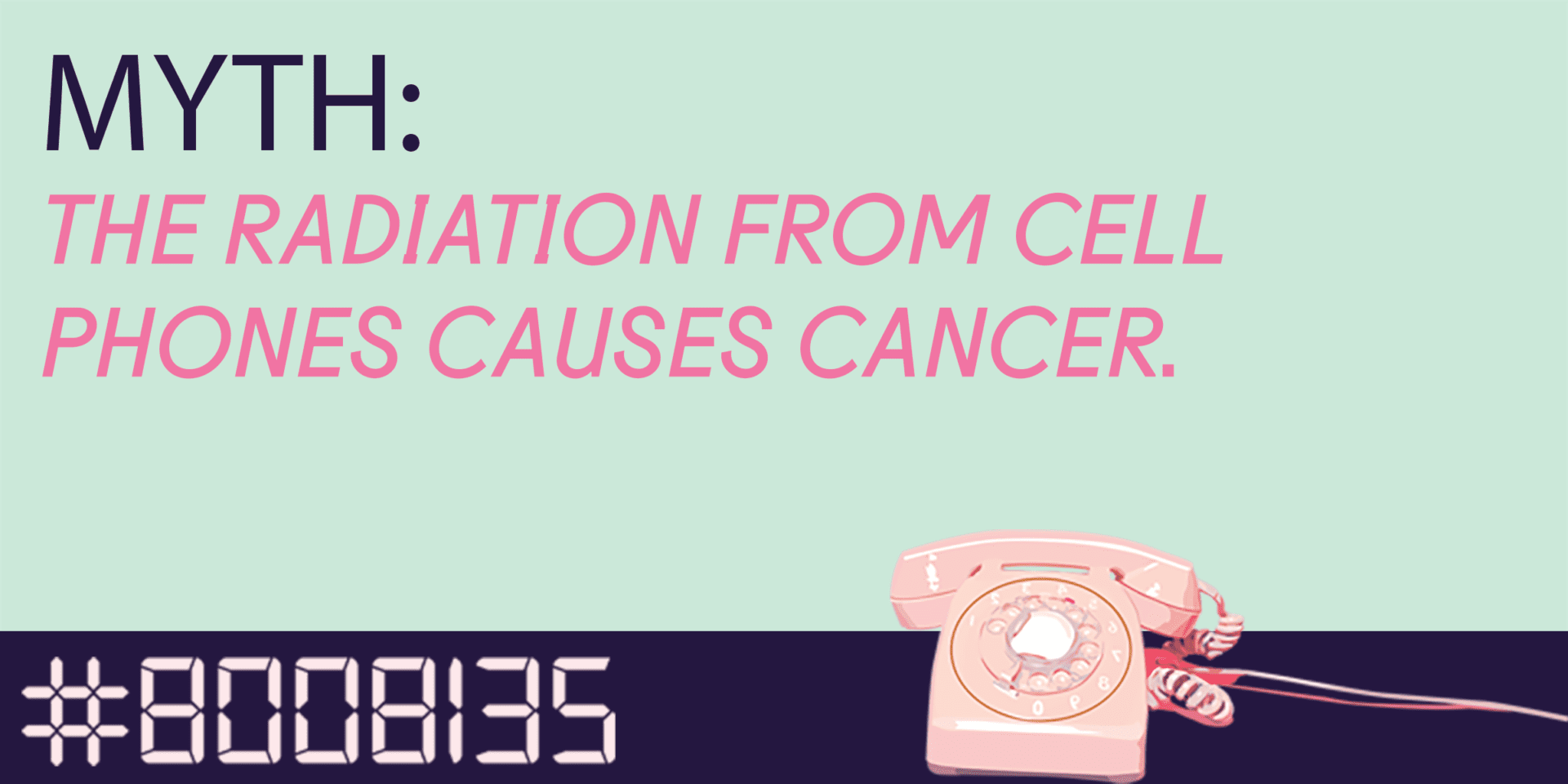
No. Most research done so far has not shown a link between cellphone use and cancer.
While it’s important that we all exercise caution around exposure to toxins and known carcinogens in our environment it’s also important that we keep complicated information/issues from being misinterpreted and spread as frightening rumours.
With the rise of cellphone use, the media and parents have been concerned about the negative effects of cellphone. Perhaps, breast cancer just got grouped into it. However, according to the American Cancer Society, the radiofrequency (RF) waves produced by cellphones are non-ionizing, meaning they cannot produce enough energy to directly damage the DNA inside cells. Types of ionizing forms of radiation include: x-rays, gamma rays, and ultraviolet (UV) rays.
The well-known Interphone Study, conducted by the World Health Organization, in 13 different countries, was the largest study investigating any potential link between cellphone use and cancerous tumours. The WHO concluded that, although more research is still needed, there is currently no connection between cellphone use and cancer.
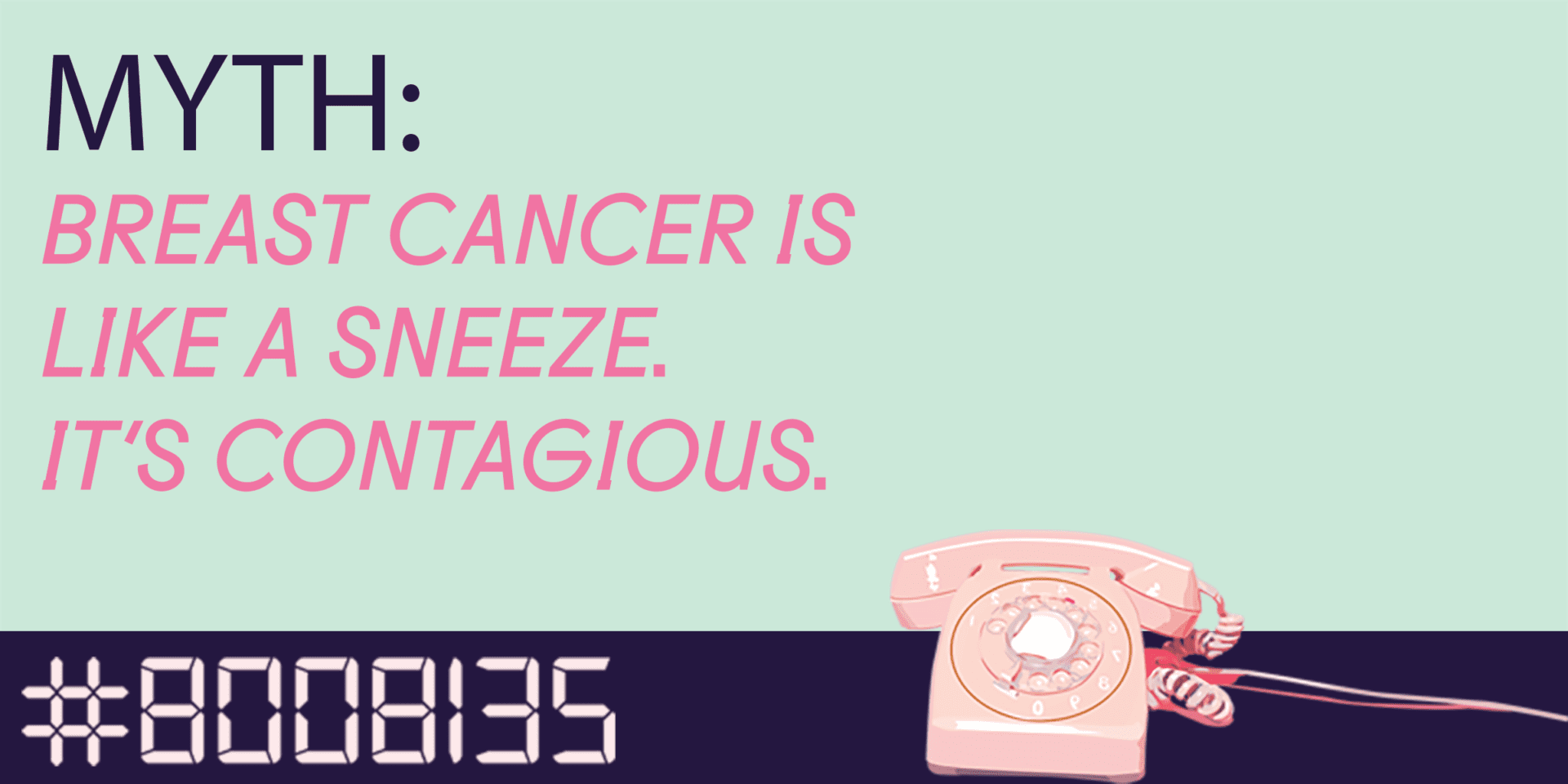
Breast cancer is not contagious. You cannot “catch” it from someone or transfer it to someone else’s body. A person’s cancer cells cannot survive inside a healthy person’s body because their immune system would destroy the foreign cells.
While it’s important that we all are doing what we can to reduce our risk of breast cancer and our exposure to known carcinogens in our environments, it’s also important that we are keeping complicated information and issues from being misinterpreted and spread as fearful rumours. A lot of people sometimes believe that cancer is contagious when they know of a family who has multiple members with cancer or when many women in the same community become diagnosed. These are known as “cancer clusters.” However, cancer clusters often form because of a similar genetics in a family or constant contact with the same risk factor (alcohol, unhealthy diet, obesity, environmental concerns, etc.).
There is no evidence that spending a lot of time with someone who has cancer, having sex with them, kissing them, or breathing the same air as them will give you cancer as well. Breast cancer is, rather, the result of the uncontrolled growth of mutated cells that begin to spread into other tissues within the breast.
You can reduce your risk by practicing a healthy lifestyle, being aware of the risk factors that most affect you, and following an early detection plan so that you will be diagnosed early if breast cancer were to occur.
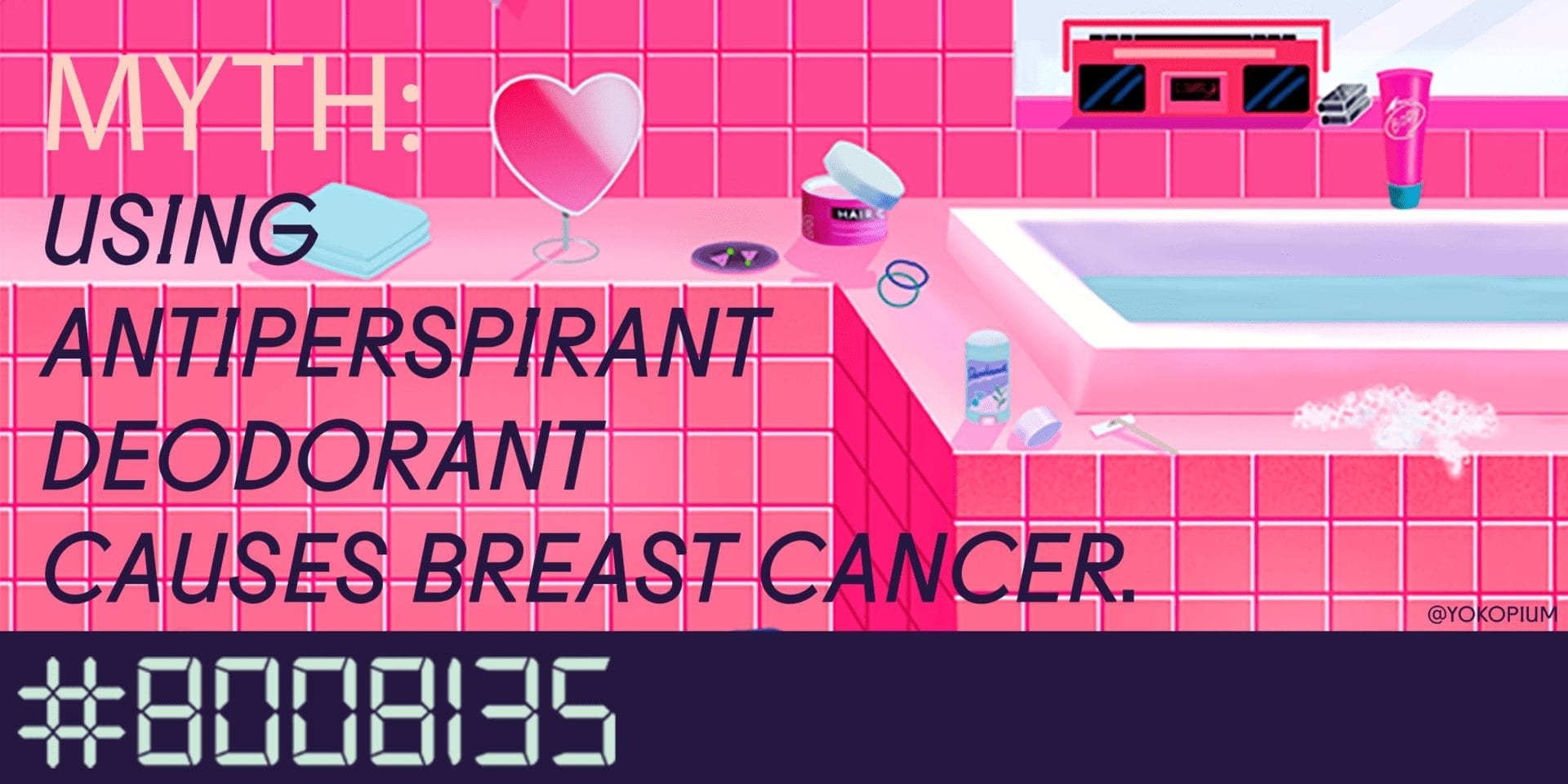
No. There has been no causal, scientific link between antiperspirant use and breast cancer.
While it’s important that we all exercise caution around exposure to toxins and known carcinogens in our environment it’s also important that we keep complicated information/issues from being misinterpreted and spread as frightening rumours.
A few studies have been published and broadcasted in the media where researchers argued that antiperspirant use is linked to breast cancer. The bases of their arguments have been:
Many of these studies were too small and lacked some significant information. Most breast cancer do occur in the upper outer part of the breast, but this is because that portion of the breast has the most tissue – automatically, making it a more likely site for cancer (regardless of deodorant use). Additionally, the Canadian Cancer Society states that the purpose of sweating is not so much to release toxins from the body, but to cool the body off (most toxins are released by the kidneys via urine or the liver). While antiperspirants are designed to reduce sweating, they cannot block 100% of sweat from leaving the body.
As far as parabens and aluminum are concerned, researchers (like Guy Eslick from the cancer epidemiology department at The University of Sydney) argue that in order for parabens or aluminum to initiate a cancerous mutation, there would need to be much higher amounts absorbed than what’s currently in deodorant products. While aluminum has been show to activate some types of breast cancer cells, this has only occurred in a petri dish – not the human body. The human body already contains aluminum in it and while it can absorb more through the skin, it can’t absorb that much.
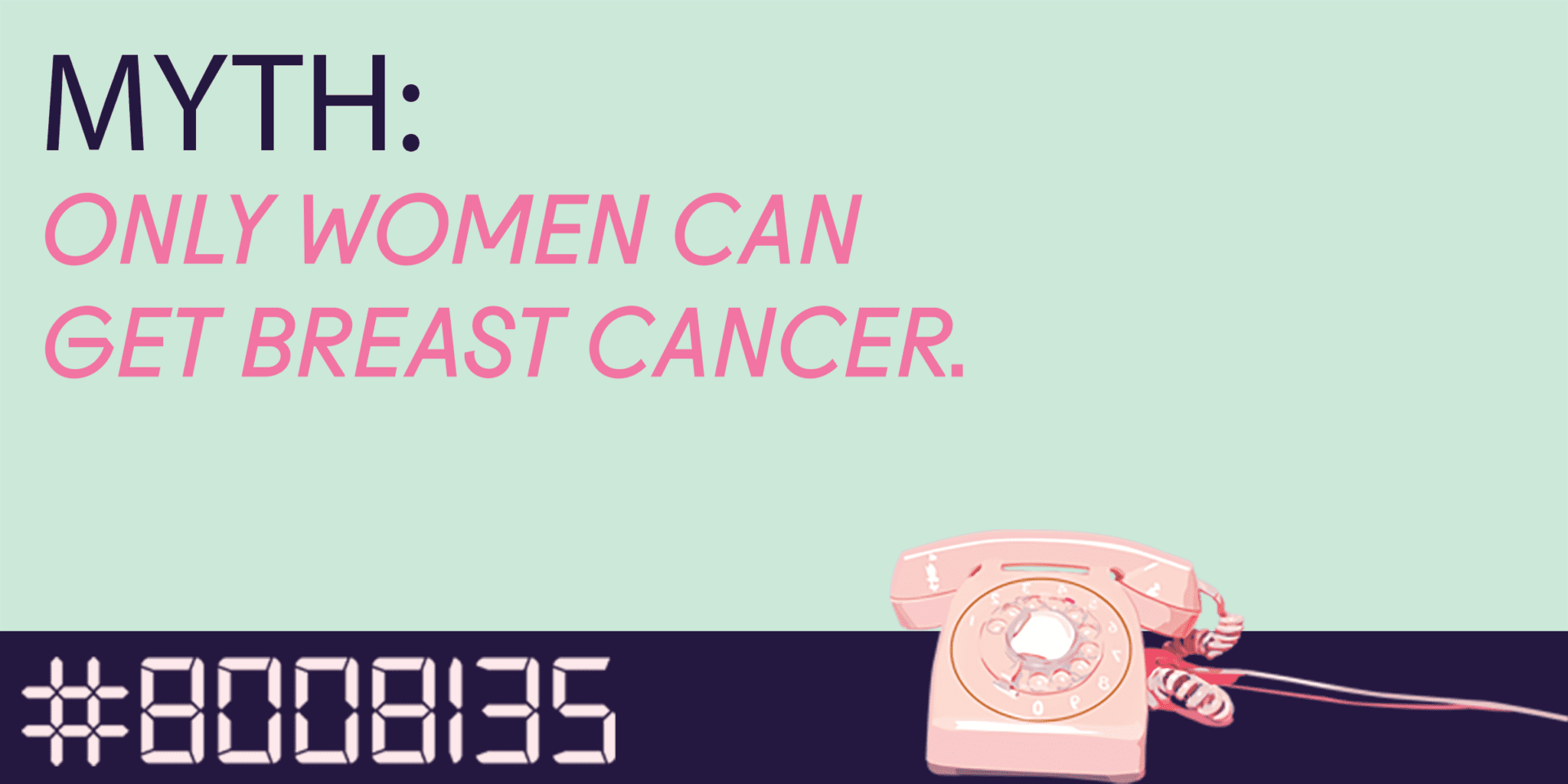
Do men get breast cancer?
Although rare, men can get breast cancer too. Breast cancer starts in breast tissue and men have breast tissue just like women, whether you can see it or not. In general, their breasts are less developed and therefore breast cancer in men makes up less than 1% of all breast cancers.
From the beginning of the breast cancer movement, it has been depicted as a women-only disease. Coverage by the media and many breast cancer organizations tend to only feature women in their images. However, this doesn’t mean the disease only affects women. It is estimated that, in 2017, there will be 230 new cases of breast cancer in Canadian men. The statistics are a bit higher for American men, with an estimation of 2,470 new cases of breast cancer in 2017. Still, these numbers are very low compared to their female counterparts (estimated 252,710 new cases in American women and 26,300 new cases in Canadian women).
The difference in risk levels between men and women is because men’s breast cells are not constantly exposed to the female hormone estrogen, which is an established risk factor in the development of many forms of breast cancer.
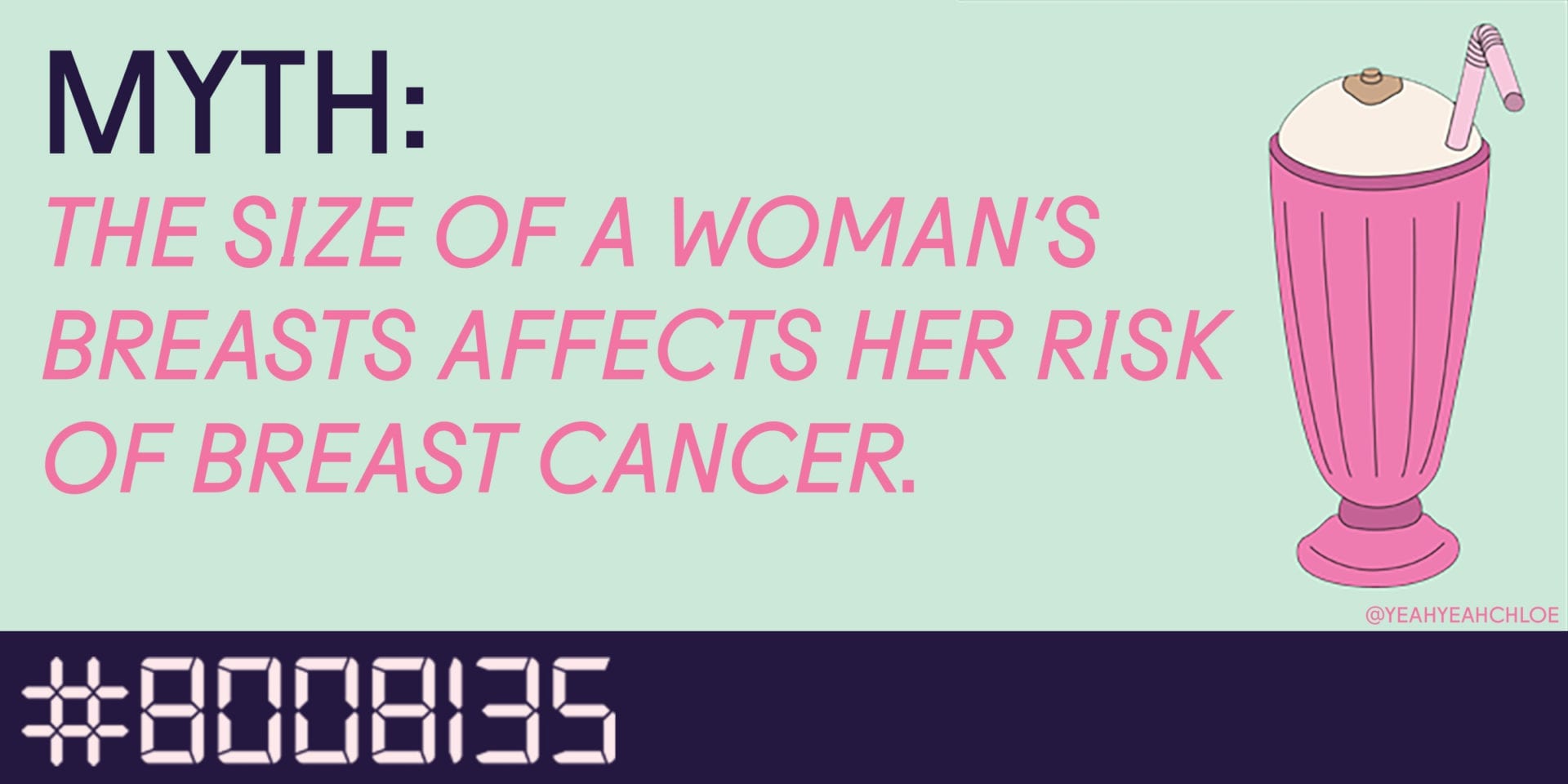
Having large breasts or small breasts does not affect your risk for developing breast cancer. Breast cancer develops in the cells that line ducts or lobules. Women of all breast sizes have the same amount of these. A woman’s breasts are large due to the presence of more fatty, or fibrous, tissue – which has little to do with cancer.
What’s more important is breast density, when breasts have greater amounts of connective and milk duct tissues, because this is where most breast cancers form. This is the only physical breast characteristic proven to increase breast cancer risk. Women with more than 75% dense breast tissue have a risk four to six times greater of breast cancer than other women. It is much harder to detect breast cancer in dense breasts using a mammogram because the tissue looks white, like tumours. There is also no link between breast size and breast density. In most cases, it is a genetic characteristic that is inherited.
For more information on how to find out if you have high breast density, click here.
While it’s important that we are doing what we can to reduce our risk by being physically active and making healthy dietary choices, it’s also important that we are keeping complicated issues and information from being misinterpreted and spread as rumours.
A lot of studies have stated that larger breasted women are more likely to develop breast cancer, contributing to this myth. However, most often these studies come to this conclusion because larger breasted women are more likely to be larger in weight or size and having a high Body Mass Index (BMI) – an indicator of body fatness – has been proven to increase breast cancer risk. A lack of physical activity is a factor that increases a person’s risk of developing breast cancer. So, regardless of breast size, if you are a healthy, active person you are already taking the steps necessary to reduce your risk.
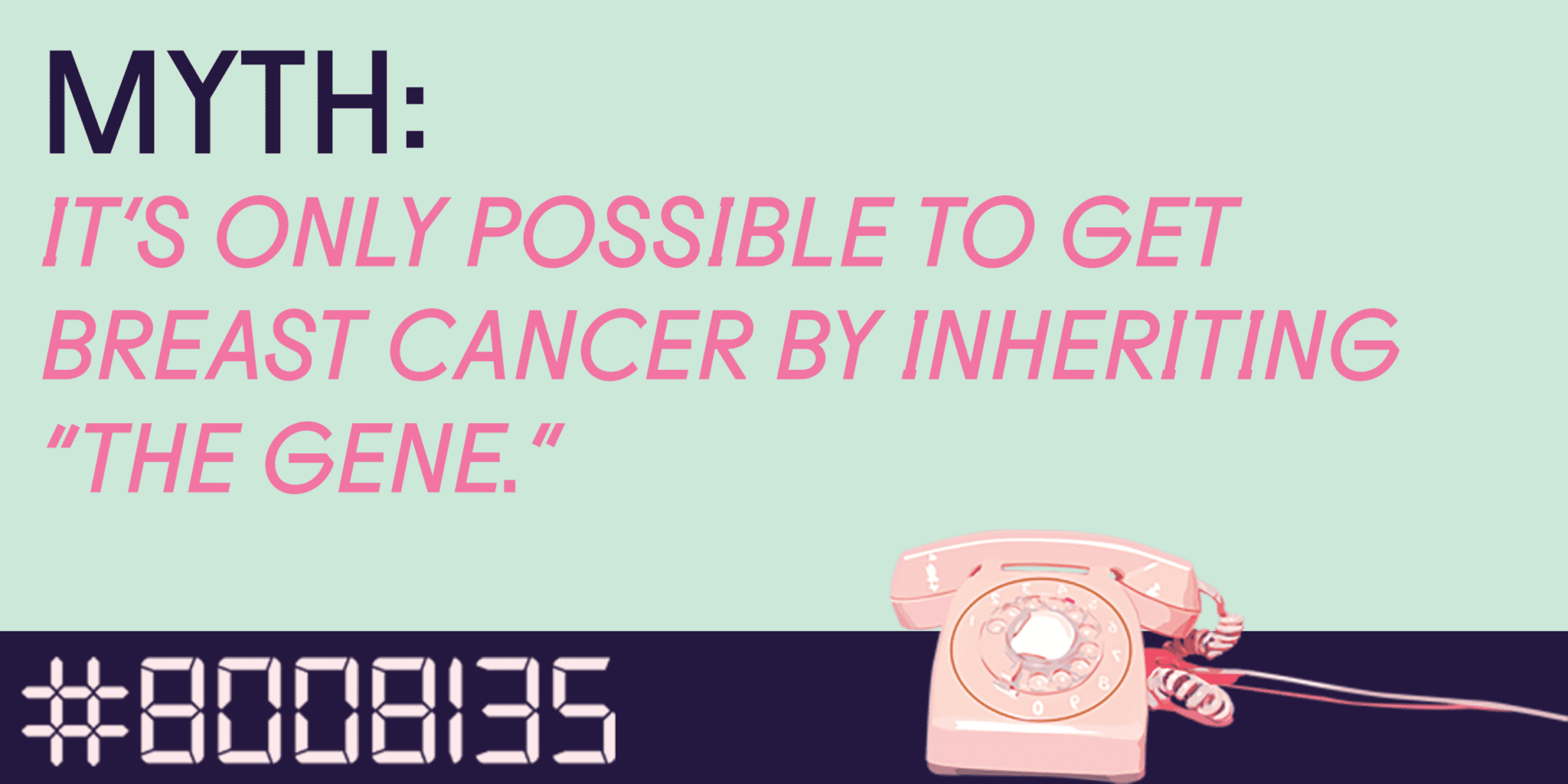
Only 5-10% of breast cancer cases are the result of genetic predisposition (BRCA-1 or BRCA-2 genes), meaning that most women who have breast cancer don’t have it in their family history.
However, women with close relatives who’ve had breast cancer have a higher risk of developing the disease themselves. If you’ve had one first-degree female relative (sister, mother, daughter) diagnosed with breast cancer, your risk is doubled.
It is also important to know your family history of cancer on your father’s side too. If you’re unsure about your family’s medical history – ask! It’s always a good idea to know where you come from (and filling in the branches on your family tree makes for a great rainy day activity).
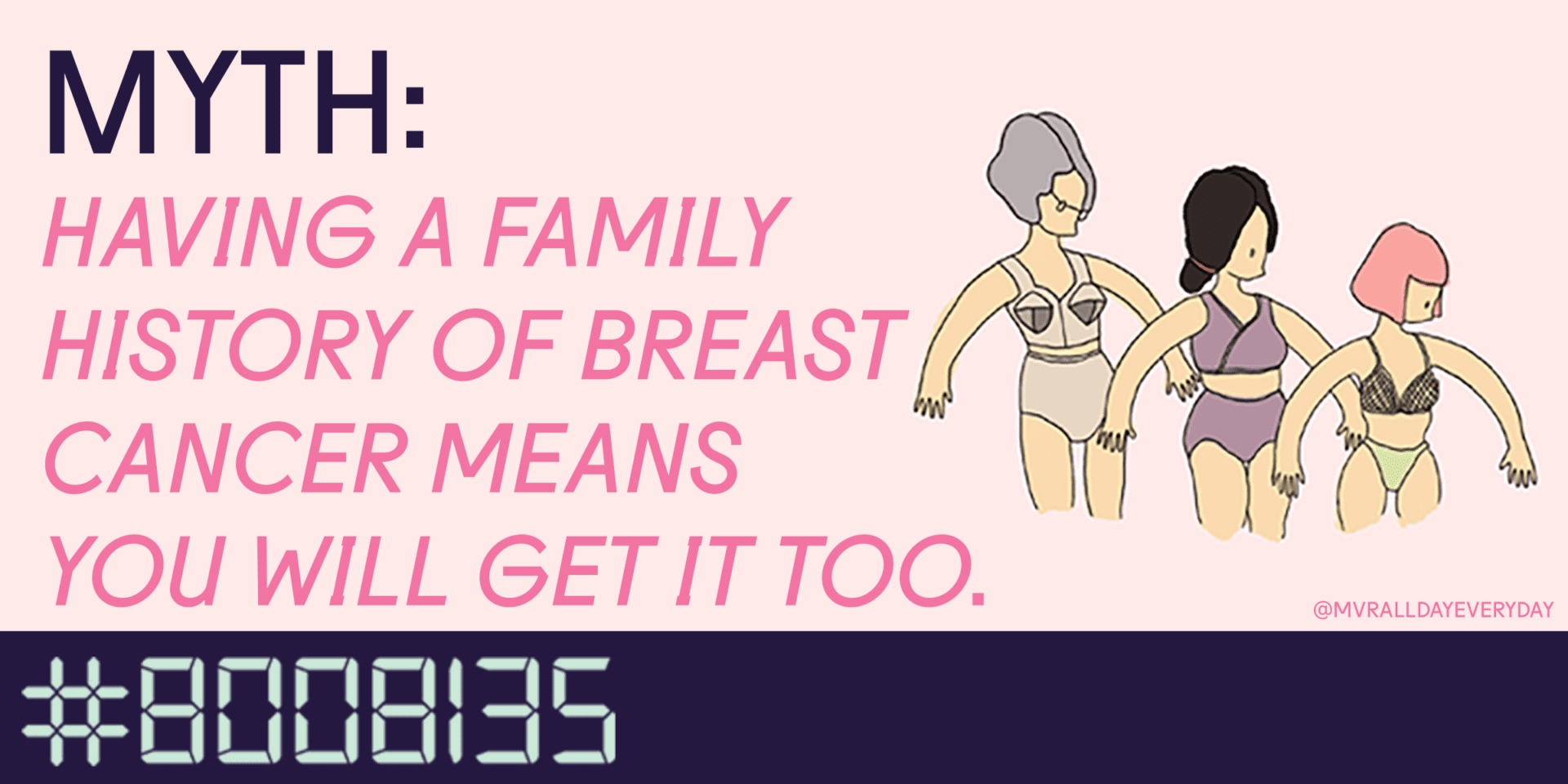
No. If someone in your family has breast cancer you are not guaranteed to get it too. Only 5-10% of breast cancers diagnoses are hereditary! However, your risk may be increased. This is usually when a first-degree (mother, daughter, sister, etc.) has been diagnosed or if you have inherited the BRCA-1 or BRCA-2 gene mutations (aka: the “Angelina Jolie genes”).
Women who possess these gene mutations have a 40-85% chance of developing breast cancer in their lifetime and are typically classified as “high risk.” They are more likely to develop breast cancer at a younger age (before menopause), and often have multiple family members with the disease.
It’s important that we are all aware of our family history when it comes to breast cancer, but it is also important that we are keeping complicated issues and information from being misinterpreted and spread as frightening rumours.
If you are concerned or unsure about your hereditary risk for breast cancer, the best things you can do are talk to your family members and ask your doctor if you are eligible for genetic testing.
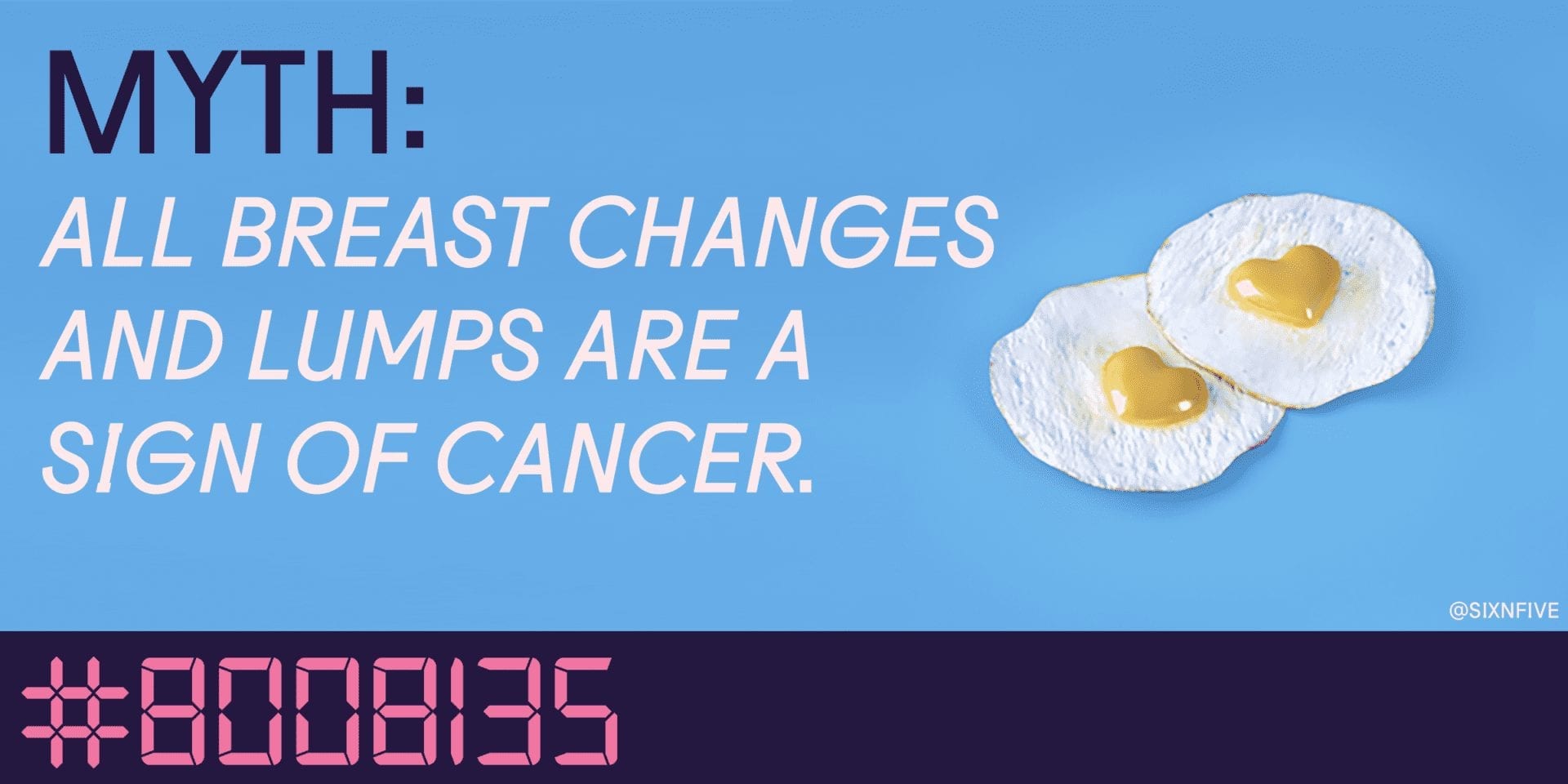
No. Over the course of a woman’s lifetime, her breasts will grow and change multiple times (puberty, menstruation, pregnancy… to name a few). Most times, these changes occur naturally, due to hormonal changes in the body, and are perfectly normal. However, you know your body best. If something feels unnatural, you can always check with your doctor.
So, what’s with the fear of breast lumps? There has been a constant dialogue about breast self-examination (BSE) since the 1960s in hopes to detect cancer early. However, there is no difference in mortality between women who practice BSE and those who find a lump naturally. Rather, BSE has increased fear, leading to an increased number of healthcare visits and twice the number of benign (non-cancerous) biopsy results. It’s more important to be breast aware.
While it’s important that we are breast aware and in tune with the changes that go on in our bodies, it’s also important that we aren’t allowing complicated information and/or issues to be misinterpreted and spread in a frightening way.
The truth is, most often, finding a lump in your breasts is nothing to freak out about. 4 out of 5 (or roughly 80%) of breast lumps are benign. There are many different types of benign breast changes/lumps. Here are a few:
For a full list, click here.
It’s always best to tell an adult that you trust and check with your health care provider if you notice that your breast looks or feels different than usual. The best time to call is when you first notice a breast change. Even if it is a false alarm, you’ll be happy you checked.